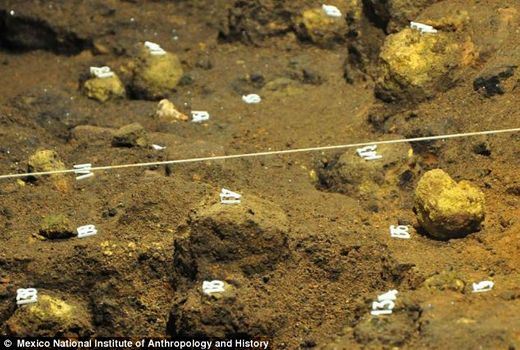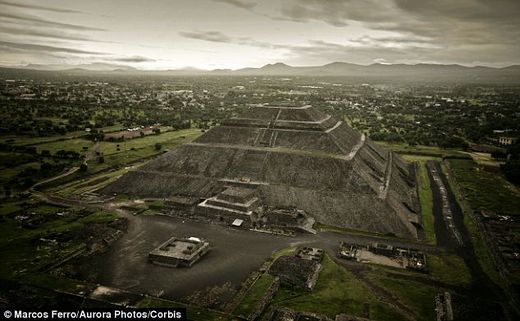Mexican archaeologists admit they have no idea what the orbs are for
Drones and robots made the discovery using infrared scanners
Hundreds of mysterious golden-coloured orbs have been found buried in a hidden chamber deep beneath the Temple of Feathered Serpent in Mexico.
The discovery was made by archaeologists from the Mexico National Institute of Anthropology and History, who admit they have no idea what the spheres are for.
A tiny robot called Tláloc II-TC, which has been scanning tunnels deep beneath the famous temple, found the orbs using infrared scanners.

They were hiding in a previously unexplored ancient chamber at the end of a stretch of 2,000-year-old unexplored tunnel on the Teotihuacan site, near the Pyramid of the Sun.
Jorge Zavala, an archaeologist on the dig said: 'They look like yellow spheres, but we do not know their meaning.
It's an unprecedented discovery.'
The spheres are made of clay and range from 1.5 to 5 inches in circumference.
They get their yellow colour from a material called jarosite.
Lead archaeologist Sergio Gomez explained that the spheres appear to be made of metal because jarosite is formed by the oxidation of pyrite, which is a metallic ore also known as Fool's Gold.
The walls in the chamber were also found to be dusted in pyrite, which gave it an appearance of a gold room.
The archaeologists therefore think that the orbs would have been used by 'high-ranking people, priests, or even rulers' to perform rituals within the tunnels.
Although, the team admit what part they played in these rituals, and what these rituals meant remain a mystery.
The team from the Mexican Institute have been using the robot for months to explore the tunnels under the celebrated temple, also known as the Temple of Quetzalcoatl.

It is best known for the towering Pyramids of the Moon and the Sun.
Earlier this year, the team and the remote-controlled robot found three unexplored passages.
It was only expected to find one.
The discovery of the hidden passages and golden orbs could be highly important.
In 2010 experts said a tomb discovery would be significant because the social structure of Teotihuacan remains a mystery after nearly 100 years of archaeological exploration at the site.
When the civilisation was abandoned, almost 50,000 high-value objects including jade, stone, shell and pottery, such as ceramic beakers, were thrown into the tunnel because it was closed up.
No depiction of a ruler, or the tomb of a monarch, has ever been found, setting the metropolis apart from other pre-Hispanic cultures that deified their rulers.
Vertical excavations begun in 2009 to reach the mouth of the tunnel suggest this was a ruler's tomb, claims Gomez.
'I think the tunnel was the central element, the main element around which the rest of the ceremonial center was built,' Gomez said. 'This was the most sacred place.'
'There is a high possibility that in this place, in the central chamber, we can find the remains of those who ruled Teotihuacan,' he added.



rocks to me. Orbs, Spheres, my foot. Some sort of mineral. Who comes up with these gag stories?